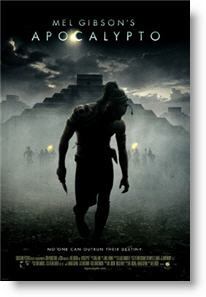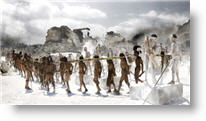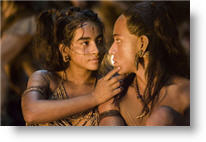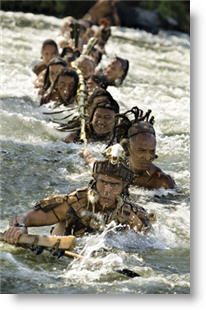Apocalypto
 for sequences of graphic violence and disturbing images.
for sequences of graphic violence and disturbing images.
Reviewed by: David Criswell, Ph.D.
CONTRIBUTOR
| Moral Rating: | Extremely Offensive |
| Moviemaking Quality: |
|
| Primary Audience: | Adults |
| Genre: | Action, Adventure, Drama |
| Length: | 2 hr. 17 min. |
| Year of Release: | 2006 |
| USA Release: |
December 8, 2006 (wide) |






| Featuring | Dalia Hernandez, Mayra Serbulo, Gerardo Taracena, Raoul Trujillo, Rudy Youngblood |
| Director |
Mel Gibson |
| Producer | Ned Dowd, Vicki Christianson, Mel Gibson |
| Distributor | Buena Vista Pictures Distribution, Eagle Pictures (Italy) |
“No one can outrun their destiny.”
In 2004 Mel Gibson shocked the Hollywood elite by self-funding “The Passion of the Christ” which went on to become the highest grossing R-rated movie of all time. The far left hit the movie with all manner of slander and venomous attacks, making “The Passion of the Christ” one of the most controversial movies of all time. Gibson’s attempt to make the movie as realistic as possible even included dialogue spoken in the “dead” languages of Latin and Aramaic. Now Gibson returns to the movie scene with another controversial movie comparable to “The Passion of the Christ” in several ways. Like the Passion, it is extremely realistic in its depiction of the violence of the culture. Like the Passion it is filmed entirely in a “dead” language. And, like the Passion, it says something that liberals do not want to hear.
First, let me say that I am a published historian. I like my historical movies to be historically accurate. That usually makes me a harsh critic of historical films. Indeed, I still believe that Gibson’s “Braveheart” is vastly overrated and exaggerated piece of fiction. I, therefore, came into this movie without any biases for or against the movie. I am also aware that many readers struggle through long reviews seeking key pieces of information that are often hidden beneath a barrage of rhetoric. I will, therefore, subdivide this review so the reader may read or omit whatever he so desires.
Film Summary
The best place to start is, of course, with the film itself. Jaguar Paw is a man who lives in a simple tribal village with his family, but his life is disrupted when invaders from the Mayan Empire enter and destroy his village, seeking victims for sacrifice. Jaguar’s pregnant wife is stranded in a cave, while Jaguar Paw is dragged off to the Mayan capital. Eventually, Jaguar escapes and is pursued through the jungle. He seeks to reunite himself with his wife and escape the barbaric empire which pursues him.
The plot is best suited to an action movie, and it is in that manner which Gibson attempts to frame most of the movie, but in so doing it misses many opportunities to rise above the violent culture it criticizes. A better script could have developed a far better movie with deeper meaning. Having said that, the script is by no means a failure. The characters feel like real people, and, unlike many Hollywood films, we actually care whether they live or die. In too many films, I am left to wonder why I care. In “Apocalypto,” I at least feel something for Jaguar Paw and his fellow tribesman.
Comparison’s to “The Passion of the Christ”
Like “The Passion of the Christ,” “Apocalypto” is a graphic depiction of a brutal and cruel series of events. Human sacrifice is depicted with little left to the imagination, but without the spiritual message of the Passion, the viewer is left feeling empty. We do not mourn for Our Savior and lament the stripes we placed upon His back, but we feel disgust for a depraved culture. Perhaps that was Gibson’s intention, but for the viewer it gives an entirely different feeling.
Another comparison is the choice of using another dead language. Will audiences tire of reading captions? Having seen the film, I found that the action nature of the movie minimized the dialogue. Like most action movies, dialogue is almost secondary. Consequently, the captions did not seem as intrusive as we might at first think. Gibson does a good job of allowing the audience to read the dialogue without missing anything in the movie. One flaw with usual captioning is that one must choose between reading dialogue or watching the movie, but since Gibson had decided to film the movie with captions, he was masterful in the pacing of the dialogue; a technique forgotten since the age of the silent cinema.
Another part of the script involves the ending, which is not particularly surprising, but effective in its own way. However, it could have been more effective, but like the Passion of the Christ, I was left wanting at the end. The ending was not bad (on the contrary, it was good), but somehow Gibson seems unable to give the endings the impact they need. In the Passion, the Resurrection almost felt tacked on. In “Apocalypto” (spoiler ahead) the appearance of the conquistadors should be dramatic and even prophetic, yet we somehow feel again as if the ending is tacked on. It did not have to be a prolonged scene, but we did need to feel the importance of their appearance. As filmed, it seemed almost a forced ending.
A final comparison is not so much in the movie as in its audience. Cynical critics suggested that the movie would fail unless Christian audiences felt loyalty to Gibson. To a degree that may be true. I was surprised to see that the audience was made up primarily of people over fifty years of age. That is not the usual target audience of R-rated movies. It may seem then that many viewers are indeed seeing the movie based on the fact that it was made by Mel Gibson, but I am curious to see exactly how well the movie will be received. It has all of the violence of the Passion of the Christ, but little of its spiritual content. Can the movie succeed?
Historical Value
On a historical level the movie is accurate to the culture it depicts. Human sacrifice was the norm and the heads and bodies of the victims were tossed down the temple steps while the heart was burned on the altar. Gibson’s attention to detail is not surprising and is evident in most of his films. Even the costumes accurately reflect the culture of the people. The scared faces, tattooed bodies, and mutilated noses and ears (excuse me, …ear and nose rings) all reflect the culture and people of the ancient Mayan civilization. Unfortunately, it is hard to tell much beyond this. The plot is focused on Jaguar Paw and his tribe rather than on the Mayans themselves, so we can only get glimpses of the culture. Nevertheless, the film accurately depicts the fierce savagery of the human race and the Mayan civilization in particular.
Morality Issues
Morally the movie is an anomaly. The violence of the Mayan civilization is condemned and yet the movie revels in violent action scenes which were not necessary to the telling of the story. I expected to see human sacrifice, so I was not surprised at seeing human hearts ripped out, nor at the decapitations, the tossing of heads and bodies from the temple, nor of the rotting corpses or the heads placed on pikes. However, the film does not end here. It contains much that is wholly unnecessary. Take, for example, the films opening sequences. After graphically depicting the capture and gutting of a boar, the testicles of the boar are given to a man who is apparently infertile. He chews on the boar testicles (which is a rather grisly scene in itself) only to find out that his friends were teasing him. The scene was meant to be “humorous.” Unfortunately, this was not the only “humorous” scene in the movie. Later, that same man is told that if he rubs his genitals with a certain plant he will be able to produce children, but, after entering a hut with his wife, he is shown screaming and running out of the hut with his hands covering his genitals. He finds a trough of water where he sits down in great pain while the tribe laughs riotously.
In addition to these scenes there are many other examples of decadence that exceed the purpose of the film. A total rundown on the violence is nearly impossible but include a dream sequence where a man stands with his beating heart in his hands, a man’s throat is slit and blood gushes down his body, the scenes of human sacrifice have already been described, a spear pierces through a man’s mouth, an arrow sticks through various men including one particularly graphic scene were the victim coughs up blood, a jaguar graphically rips at a man’s head, another man cuts his veins open, a man smashes his brains against the rocks after falling from a waterfall, and a particularly gory scene occurs at the end when our hero smashes a man’s head. We see blood spurting from his partially exposed brain. Many other similar scenes could be cited, but this should include the most graphic moments.
Surprisingly, the movie does not stop at violence. Perhaps it is not too surprising that there is nudity in the movie as various women’s breasts can be seen, and all the men’s buttocks are visible. Nor is it surprising that there are implied, but thankfully not shown, scenes of rape. It is, however, surprising that Gibson not only found time for the sexual humiliation described above, but the F-word actually makes its appearance in this film. Doubtless the word was meant to be humorous, since no ancient culture spoke of a dying man being “f___ed,” but it does illustrate that the film inadvertently winds up saying as much about our own dying culture as it does that of the Mayans.
The Controversy
The controversy over this movie has been quelled somewhat by a cautious, if not hypocritical, media. While decrying the violence in the Passion of the Christ, the critics seemed to have soft-pedaled somewhat in regard to the violence of “Apocalypto.” The real controversies, however, is the subject of the fall of the Mayan civilization itself. The movie begins with a quote from Dumont, reading, “a great civilization does not fall from without until it has fallen from within.” The entire movie builds up to the question of whether or not the conquest of Old Mexico by the conquistadors was really a bad thing. Clearly Gibson’s view is that it is not a bad thing. This is the message that revisionists despise. They lament the “great civilizations” destroyed by the barbaric Conquistadors, but Mel Gibson depicts a civilization that was far from great. Moreover, he does it with prophetic overtones. Mayan prophecies of the fall of their civilization are interwoven into the story. The audience is, at times, led to believe that it is Jaguar Paw himself who is the subject of the prophecies, but the ending of the movie makes it clear that it is the Europeans themselves who are prophesied.
Perhaps Mel was able to offset some of this politically correct criticism by emphasizing the cruelties that the Mayans placed upon their own people. Indeed, the words of a Mexican slave recorded in the pages of history accurately reflect the truth of history when he said that the slavery they now endured under Spain was as freedom compared to the slavery they endured under the great empires of Old Mexico (quoted from The Rise and Fall of the Holy Roman Empire, pp. 424-440). In this respect, Mel Gibson’s film is true to history. It is important to realize exactly how depraved cultures without the God of Israel and his Messiah, Jesus, truly are. Whether it was ancient Europe (where cannibalism and human sacrifice took place), or Africa, or the Americas, all cultures which know nothing of the God of the Bible fall into a depravity from which there is no hope of recovery, save the destruction of their culture and appearance of the Scriptures. Yes, even the Spanish Catholics with all their barbaric and heretical ways (including the Inquisition) looked as saviors to the people of Old Mexico. That is why the Conquistadors succeeded. Cortez took the Aztec empire of a million people with only five hundred men, because he viewed as a liberator. Two hundred thousand Tlaxacan indians fought side by side with Cortez when he took Mexico city. They were a people who gods were decaying. Even the most depraved perversion of Christianity (as seen in the Spanish-Catholic Inquisition) brought a hope that the people had never known.
Conclusion
In the end, I cannot truly recommend the movie to a Christian. The violence far exceeds its purpose and without the spiritual context which was evident in “The Passion of the Christ”, “Apocalypto” proves to be a long, depressing, and violent movie. The hope that should have been evident at the end of the movie was stifled in much the same way that the Resurrection was in “The Passion of the Christ.” What a powerful ending it might have been, and what a powerful movie it might have been, had Gibson been able to move beyond a violent action film. Nevertheless, I find it hard to give fewer than three stars on account of Gibson’s visually stunning direction. As always Gibson proves to be a director that knows how to impress visually and who adds a stark realism that most movies lack. On a cinematic level one might asks, “can you really outrun a jaguar”?, and one ponder the off color humor that Gibson injected, but most everything succeeded visually and emotionally. It is, therefore, with regret that I cannot truly recommend the film.
Violence: Extreme / Profanity: Moderate / Sex/Nudity: Moderate


Offensive / 5
Extremely Offensive / 4
Sometimes we need to see the graphic reality in order to be convinced. I read in other reviews that this film was probably made to not only show how barbaric the South and Central American Native cultures were, but also force the viewers to ask themselves which Central/South American culture was beneficial to the Natives, that of the former Mayan or Aztec, or that of the Hispanic.
I was taught that the Aztec and Mayan cultures were flourishing cultures that were snuffed out by the big bad Spanish Catholics, but looking at the pre-spanish Central/South American culture, I wonder if the forced change in their cultures was so bad. I spoke with a South American Christian who said although the Spaniards were terrible to the Natives, the Spaniards brought Christianity with them, 'God had a plan, and although the treatment of the Spaniards was terrible, God used them to bring Christ to us, and I find being saved by the Blood of Christ more important than anything else.' Along with the graphic depictions of the Spanish treatment of the Natives, the Roman Catholic Church was seen as a sanctuary to many Natives during the troublesome times (see the film, “The Mission”).
When all is said and done, one must ask a Central or South American which would they prefer to have, a Mayan or Aztec culture? or a Spanish-like Christian culture?
Average / 5
Better than Average / 5
Offensive / 4
Very Offensive / 4½
Very Offensive / 3
Extremely Offensive / 2½
Extremely Offensive / 5
Offensive / 5
It is imperialistic to say that the only way to spread Christianity is to destroy the language and culture of an entire people and replace it with one that is not legitimate. And the Spanish language and culture is not and never will be legitimate for the indigenous peoples of Mexico.
I would also like the reviewer to point out the so called love, mercy, and forgiveness that the Spaniards brought to Mexico? Because I look at Mexico today and I don’t see any of that. It was good to spread Christianity, but I hardly think that excuses the Spaniards atrocities, no matter how barbaric the Mayans were.
Moral rating: Extremely Offensive / Moviemaking quality: 4½


Once I accepted that fact, I did enjoy the show very much. As with any film, you are stepping into a story (whether good or bad being left to the viewer). The captioning which I also thought in the beginning was a bother is not like other films. They way they are placed in the action—you don’t miss the movie while reading the caption as with other shows—it blends well. My take from the show: sure it was gruesome, man fighting man, which has been the focal point of history classes for ages. This film “places you there,” it is accurate and tells a good story of facing fear and never giving up.
However, I don’t think anyone under 18 should view it due to the graphic content. I left the theatre thinking this final thought: Wow, I wonder what the Native American Indians really went through. History is a sad reality often sugar-coated and overlooked.
My Ratings: Offensive / 5